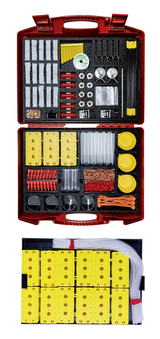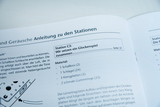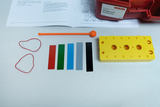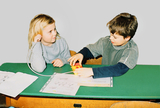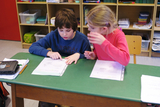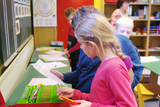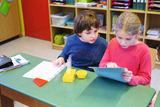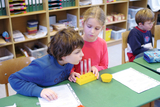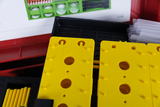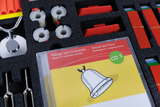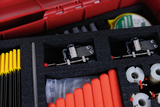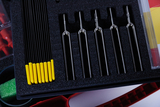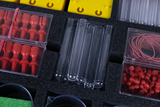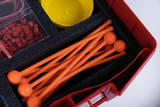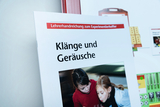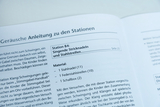Students kit Sound and tone
This kit can be used in lessons covering physical and technical subjects as well as music and languages in grades 2 to 4.
The kit is especially suitable for learning in groups at specific workstations but can be used for any other type of lesson too.
The experiments focus on the phenomenon of sound: how sounds and noises are produced, that they are vibrations, that they can be transmitted and amplified, and what determines their pitch and volume.
No special material preparation is required, other than providing a CD player (1 CD is included).
The materials are suitable for all teaching formats but are especially well-suited for station-based learning in pairs.
With the included sound CD, children can match, recognize, and name sounds, distinguish sound twins, and reenact a sound story.
Needed in addition: CD player
Teacher’s manual
- with sheets for each workstation including basic information on the topic and on the organisa-tion of workstations
- plus supplementary educational and organisational tips.
Age 8-12
Materials for up to 25 workstations (for 25 children at least)
Technical specifications
Size of kit: 540 x 450 x 150 mm
The students match the different sounds on a sound CD.
Here, students match sounds and sound-naming verbs.
A rubber ring zither can be used to explore the relationships between "string" length, gauge and tension on the one hand and "tone" pitch on the other.
The students use the test tubes as a pan flute.
The sound of a vibrating body (here a rubber ring) can be changed by a resonating body, although this is initially only noticeable in the volume.
In this experiment, the soft tapping sounds on a soft tube are clearly perceived.
A string transmits sound stronger and faster than air, but only when it is taut. The students can observe this phenomenon with a can telephone.
The students can listen to heart sounds with the help of a stethoscope.
Children know from experience from swimming that you can hear well under water, but here the comparison is possible: you can hear the struck tuning fork vibrating in the water without a tube - using only the air as a transmitter - and through the tube.
The students assign sound twins.
The students assign a sequence of sounds to a storyline.
The students use a tuning fork and can establish a connection between vibrations and sound through various experiments.
With these experiments, students can explore the connection between vibrations and sounds in a playful way.
Students* assemble a carillon. The learning outcome of assembling and trying out the glockenspiel is the following insights: Of a set of plates, the longest sounds the lowest and the shortest sounds the highest.
On the "thumb piano", the relationships between the length of the vibrating steel strip and the pitch can be tested quite "naturally".
With the combination music box / sound box you can experience how strongly the sound is amplified by a resonating body.
A corpus determines not only the volume, but also the sound of an instrument quite significantly, as it resonates in its own way.
The can does not "cackle", it only makes the vibrations on the string audible. To do this, it must be made to vibrate.
A soft sound is audible. How does it reach the ear? The children soon find out that it must be the air. They may also have heard that you can't hear anything where there is no air (in space) - or conversely, that you can hear very well under water.
On the level of physics, this is about the transmission of sound - via the string held taut and the finger bones. Beyond that, however, there is much else to discover. For example, one can determine the different distance of the tuning forks and also the proximity to one of the two ears. Also, the sound of the tuning forks gets a completely different character when it is not conducted into the ear via the air, but via string and fingers (!).
- 15 × Plastic test tube, 100 mm
- 1 × Sewing thread, 100 m
- 1 × Paper clips (100 pcs.)
- 1 × Plastic box, clear, 60/40
- 4 × Plastic box 140/50/35 mm
- 30 × Plastic test tube, 152 mm
- 15 × Plastic dish, 80 mm Ø
- 15 × Sound box, 3 parts
- 36 × Cord stretcher
- 15 × Triangular bridge
- 15 × Tuning fork, 105 mm long not tuned
- 30 × Flexible hearing tubing 630 mm
- 15 × Set of 5 sound plates
- 1 × Set of 100 rubber rings for soundplates
- 15 × Plastic mallet, 160 mm (drum stick)
- 15 × Spring steel strip with oscillation head, 300 mm
- 2 × Stethoscope chest-piece
- 3 × Pair of monochord-strings
- 1 × Pan pipe, plastic
- 2 × Music box with crank handle
- 1 × Membrane slider
- 8 × Cord with membrane plates
- 4 × Beaker w. punctured base
- 1 × Foam insert 1 for 31720, 505x355x30 mm
- 1 × Foam insert 2 for 31720, 515x370x70 mm
- 1 × Storing diagram,int.vers.
- 2 × Tray 510x360x20 mm
- 1 × Plastic case ca.540x450x150 mm
- 1 × Demonstration cord 20 m, 1 mm Ø
- 4 × Cable fixer, velcro
- 15 ×
- 125 ×
- 1 ×
- 1 ×
- 5 ×
- 20 ×
- 2 ×

